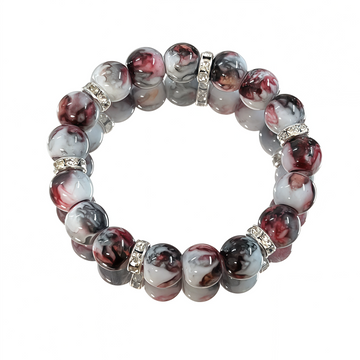Restoring Luster and Maintenance Practices for Stone Bracelets
Stone bracelets, crafted from materials like jade, agate, or quartz, often lose their natural sheen over time due to wear, environmental factors, or improper care. To preserve their aesthetic appeal and structural integrity, implementing a targeted cleaning routine and adopting preventive measures are essential. Below are actionable strategies to revive dullness, protect against damage, and extend the lifespan of stone bracelets.
Deep Cleaning to Restore Natural Shine
Regular cleaning removes dirt, oils, and residues that dull the stone’s surface. Follow these steps for effective results:
Gentle Soaking: Submerge the bracelet in lukewarm water mixed with mild dish soap for 10–15 minutes. Avoid hot water, as it may cause thermal stress to the stone or adhesive.
Soft Brushing: Use a soft-bristled toothbrush to gently scrub crevices and textured areas. Focus on removing debris without applying excessive pressure, especially for porous stones like turquoise.
Rinsing and Drying: Rinse thoroughly under running water to eliminate soap residue. Pat dry with a lint-free cloth to prevent water spots. For intricate designs, air-dry in a shaded area to avoid trapped moisture.
Polishing Techniques for Enhanced Luster
Polishing rejuvenates the stone’s surface by smoothing micro-abrasions and restoring its reflective properties. Consider these methods:
Natural Oil Application: Apply a drop of mineral oil or jojoba oil to a microfiber cloth and buff the bracelet in circular motions. This method works well for opaque stones like jade, enhancing their translucency.
Professional Polishing Cloths: Use specialized jewelry cloths designed for stone surfaces. These cloths are treated with polishing compounds that gently remove oxidation and tarnish without scratching.
Ultrasonic Cleaner Precautions: While ultrasonic cleaners are effective for metal components, use them cautiously for stone bracelets. Avoid prolonged exposure and opt for short cycles to prevent internal fractures in delicate stones.
Protective Storage and Handling Practices
Preventing future damage is as crucial as restoring existing luster. Adopt these habits to safeguard your bracelet:
Separate Storage: Store the bracelet in a soft pouch or lined jewelry box to avoid scratches from contact with harder materials. For multi-stone bracelets, wrap each piece individually.
Avoid Chemical Exposure: Remove the bracelet before applying lotions, perfumes, or household cleaners. Chemicals can erode the stone’s surface or weaken adhesives in settings.
Limit Environmental Stress: Protect the bracelet from extreme temperatures, direct sunlight, and humidity. For example, avoid wearing it in saunas or while swimming, as chlorine and saltwater can damage porous stones.
Routine Maintenance for Long-Term Care
Consistent upkeep ensures the bracelet retains its beauty over time. Incorporate these practices into your routine:
Monthly Inspections: Check for loose stones, worn clasps, or fraying threads (if strung). Address issues promptly to prevent further damage.
Reapplication of Protective Coatings: For stones prone to drying out, such as opal, apply a thin layer of wax or sealant every 6–12 months to maintain hydration and luster.
Seasonal Adjustments: Rotate bracelets in your collection to minimize exposure to daily wear. This reduces the risk of accidental impacts and extends the lifespan of each piece.
By combining thorough cleaning, targeted polishing, and proactive protection, stone bracelets can maintain their radiance for decades. Whether worn daily or saved for special occasions, these maintenance practices ensure that each piece remains a cherished accessory.







